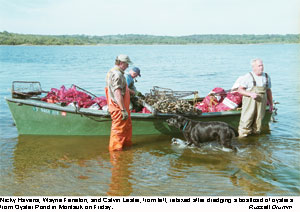A Relay From Pond to Harbor

Like a soft white curtain, Friday's early-morning fog lifted from the surface of Oyster Pond in Montauk to reveal two small boats moving in tight circles against the backdrop of rolling hills, a forest of oak and shad, and a dense hedge of gently swaying beach reeds.
By the end of the day, the baymen Wayne Fenelon, Nick Havens, Calvin Lester, Nat Bennett, and Paul Lester had dredged 260 bushels of oysters.
The shellfish were then "relayed" into Accabonac Harbor, where, in about a month, and when conditions are right, they will be available for harvest. Friday's relay was authorized by the East Hampton Town Trustees in cooperation with the State Department of Environmental Conservation and the East Hampton Town Natural Resources Department.
Trustee records show that during the 18th and 19th centuries, oysters from Oyster Pond in Montauk were so plentiful they were routinely exported to Connecticut. Long before that, the pond's brackish waters supplied Montaukett Indians with their shellfish.
The pond has been closed to shellfishing since 1986, but the delicious shellfish for which it was named continue to find their way to market by a safe, albeit roundabout, route. In addition to the periodic relays, Oyster Pond oysters have served as brood stock at the town shellfish hatchery on Fort Pond Bay in Montauk. Seed oysters derived from the pond's stock populated the pilot aquaculture projects in Napeague Harbor beginning in 1995. Spawn from transplanted oysters add to the natural set in other town waters.
The Indians called it Munchogue. Early East Hampton and Amagansett settlers set up hunting camps along its banks. At the southwest corner is Hetty's Hole, a spot where streams enter, a breeding ground for endangered leopard frogs. Seals haul out on the rocks just over the dunes that separate the pond from Block Island Sound. The secluded pond is large, approximately 100 acres, and lies within parklands purchased by the state in the 1950s. Theodore Roosevelt County Park borders Oyster Pond on the west, Montauk Point State Park on the east. Periodically, storms cut through the narrow sand spit that separates it from the sound.
In recent times the pond was certified for shellfishing from 1970 to 1975. In 1980 and in 1985, testing by the State Department of Environmental Conservation showed safe levels of coliform bacteria, and baymen were able to harvest oysters. But, beginning in 1986, the D.E.C. put the pond off limits because of high coliform counts, mostly from animal waste, according to Larry Penny, East Hampton Town's director of natural resources. Natural coliform levels were increased in the late '80s by a faulty septic system at the Camp Hero community upstream from the pond.
Since then, Mr. Penny's office has helped the D.E.C. collect water samples for periodic testing. Mr. Penny said that coliform counts were lower these days, but added that most of the recent testing was done during last summer's dry spell. Coliform counts tend to be higher when bacteria is carried into the pond by rainwater.
Since the early '90s, the D.E.C. has authorized several oyster relays in cooperation with the trustees of both Southampton and East Hampton Towns. After 21 days, the oysters are considered free of pathogens.
However, the north end of Accabonac Harbor, where they were placed, is "conditionally certified." For the last few years, this has meant that the beds were closed to shellfishermen for seven days after rainfalls of a quarter of an inch or more. The D.E.C.'s criteria for the coming year have not been announced.
Bill Taylor, waterways management supervisor, said it was possible that another oyster transplant would be undertaken in the spring. If so, oysters would probably be relayed to sections of other town waters.
